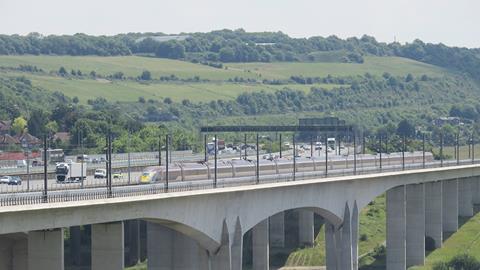Britain’s sole high speed railway and its link to continental Europe, High Speed 1 can lead the transport decarbonisation charge, but it needs support to bounce back from Covid-19 first, argues HS1 Ltd Chief Executive Dyan Crowther.

With COP26 rapidly approaching and ‘sustainability’ becoming an ever-present word in corporate thinking, businesses are going through a much-needed shift in mindset when it comes to their carbon footprint.
Two decades ago, most would have shrugged at making environmental impact central to a company’s long-term vision — growth is something that was always seen as good for the economy after all, regardless of the resources needed to secure it.
The transport and infrastructure sectors in particular will have been guilty of this; improving connectivity, passenger experience and capacity have always been driving forces for transport operators — environmental impact has featured relatively little until recently.
Thankfully companies in every sector have realised they need to now look at how they deliver their service to be truly sustainable. Transport especially has to face this reality; in 2019 the sector produced just over a quarter of the UK’s total emissions.
That’s why the Department for Transport’s Transport Decarbonisation Plan, published on July 14, is so welcome. The much-awaited document sets out a clear ambition to turn this traditionally environmentally-unfriendly sector into a beacon of sustainability.
It was encouraging to see such a heavy focus on modal shift throughout the document alongside other measures such as alternative fuels for our most polluting services. Only through significant changes in the modes of transport we use are we likely to see the target for a net-zero sector met.
This gives extra importance to the work of the rail sector in the coming years; its green credentials and high levels of connectivity and accessibility mean it has the potential to be the backbone of Britain’s transport network as we move to a low-carbon future.
Fostering international links
But a focus on modal shift to domestic rail misses an even more obvious and high-impact recommendation. International rail has already proven to be a commercial success while offering a huge reduction in CO2 compared to short haul aviation.
Average carbon emissions are up to 93% lower for rail passengers than airline passengers over the same distance. Before the pandemic, international trains using HS1 removed the equivalent of 60 000 short-haul flights from the skies every year, plus 6 000 cars and lorries from the roads, equivalent to 750 000 tonnes of carbon dioxide per year. And on the domestic side, services on HS1 provide commuters in Kent with high-quality train services that deliver significant time savings and support car-free commuting.
Even before the Transport Decarbonisation plan was issued, HS1 Ltd had pledged to be fully carbon neutral within a decade. Alongside our operators Eurostar and Southeastern, we want to reduce the carbon footprint of every passenger by 25% and to cut the energy consumed per journey by 10%. And by 2023, we’ve pledged to recycle 90% of our waste generated from operations and major projects, meaning that HS1 Ltd is determined to lead on more than just emissions.
The Green Gateway
HS1 is dubbed the ‘Green Gateway’ to Europe. Pre-pandemic, almost 4 million of the 26 million people who used the line’s international and domestic services each year had switched from using cars and flights.
We know that we can multiply these benefits even further through increased use — the benefits only increase as more people use the railway, and the stronger our contribution to the net-zero agenda. Through our official partnership with the World Climate Summit, known as The Investment COP 2021, we’re calling for an even greater modal shift in the short-haul international travel sector by transferring 4·9 million more passengers to high-speed rail.
Such a shift could prevent a further 450 000 tonnes of CO2 from entering our atmosphere. We have the capacity to double use of the HS1 infrastructure by 2030 and deliver approximately £427m more in economic benefits.
Delivering recovery
But we can’t take this growth for granted; like all sectors of transport, the Covid pandemic has run a demolition ball through passenger numbers. In 2019, Eurostar services carried more than 11 million passengers, but since March 2020 the cross-Channel operator has seen passenger revenue drop 95%. While the HS1 model generated a profit before the pandemic, we cannot assume that we will return to the black without support.
Without the right support for HS1 and its operators, pent-up consumer demand is likely to be met by short-haul airlines, leading to an exponential increase in emissions. That is why we have produced an international high speed rail recovery report, showing the steps needed to get HS1 back to delivering the green gateway we’ve so proudly built in the last few decades.
Among the key recommendations the report sets out is the need to deliver frictionless travel at the borders. This includes modernising juxtaposed border controls, increasing digitalisation of the border process, and accelerating implementation of the government’s 2025 UK Border Strategy.
More long-term, we need to see financial and regulatory changes that would protect and enhance HS1. This includes ensuring there is harmony in financial relief and consumer benefits between rail and air passengers, reviewing business rates and duty-free shopping regulations, and creating a landside duty-free offering.
It also means supporting HS1 Ltd in its attempts to broaden the range of services that the line carries and improve consumer choice. The more routes that we can offer to challenge the short-haul flight sector, the more passengers we can help to travel sustainably.
Dyan Crowther is Chief Executive of HS1 Ltd, which holds a 30-year concession to manage High Speed 1, the 109 km route linking London St Pancras with the Channel Tunnel. It is owned by a consortium comprising funds advised and managed by InfraRed Capital Partners and Equitix Investment Management.




